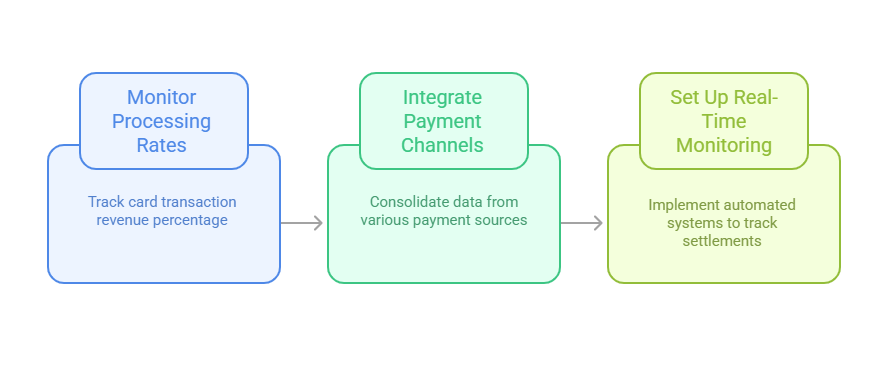Understanding how daily remittance actually works can transform your business's financial operations. Daily remittance involves the systematic processing and handling of payments received throughout each business day, typically through automated systems that capture, match, and reconcile transactions. For small business owners, this process represents a critical component of cash flow management and financial accuracy. Modern remittance systems leverage automation to eliminate manual errors and speed up payment settlements, creating more predictable revenue streams for businesses across various industries.
Essential Tips for Streamlining Your Card Sales Percentage Processing

- Monitor your processing rates regularly: Keep track of how much of your daily revenue comes from card transactions. This card sales percentage data helps you understand payment patterns and optimize your remittance timing.
- Integrate multiple payment channels: Consolidating data from various payment sources into a single system can significantly reduce administrative costs. This approach also enhances financial accuracy by providing a complete view of daily transactions.
- Set up real-time monitoring: Automated systems can track payment settlements as they happen throughout the day. This immediate visibility helps identify any processing delays or discrepancies before they impact your cash flow.
Key Benefits of Automation Process Implementation
- Reduce manual labor and human error: Implementing an automation process eliminates the need for manual payment matching and data entry. This reduction in human intervention leads to fewer mistakes and faster processing times.
- Improve settlement speed: Automated remittance systems can process payments much faster than manual methods. This efficiency means businesses often see improved cash flow and more predictable revenue timing.
- Enhance financial record keeping: Precise financial records become much easier to maintain when automation handles the data collection and organization. This accuracy supports better strategic planning and regulatory compliance.
Advanced Strategies for Merchant Account Integration Success
- Ensure seamless data flow: Proper merchant account integration allows payment information to move smoothly between your processing systems and accounting software. This connectivity reduces the risk of lost transactions or mismatched records.
- Configure automatic reconciliation: When your merchant account feeds directly into your remittance system, daily reconciliation becomes nearly effortless. This setup can save hours of manual work each week while improving accuracy.
- Establish backup procedures: Even automated systems need contingency plans for technical issues or processing delays. Having clear backup procedures ensures your remittance operations continue smoothly during unexpected disruptions.
Understanding Your Business Repayment Rhythm
- Analyze your daily transaction patterns: Most businesses develop a natural repayment rhythm based on their industry and customer base. Understanding these patterns helps optimize when and how often remittance processing occurs throughout each business day.
- Align processing with cash flow needs: Your business might benefit from multiple daily remittance cycles rather than a single end-of-day process. This approach can improve working capital availability for businesses with high transaction volumes.
- Consider seasonal variations: Many businesses experience fluctuations in transaction volume throughout the year. Adjusting your remittance schedule to account for these changes can help maintain consistent cash flow management.
- Monitor processing costs: Different remittance frequencies may have varying cost structures. Balancing processing fees against cash flow benefits helps determine the most cost-effective approach for your specific business model.
Steps to Optimize Payment Settlement Timing

- Map your current processing timeline: Document how long each step of your remittance process currently takes from initial payment to final settlement. This baseline helps identify bottlenecks and improvement opportunities.
- Implement batch processing strategies: Grouping similar transactions together can often reduce processing time and costs. This approach works particularly well for businesses with predictable transaction patterns.
- Set up automated notifications: Real-time alerts about processing status, delays, or exceptions help business owners stay informed without constantly monitoring systems. These notifications can prevent small issues from becoming major problems.
- Establish performance metrics: Track key indicators like processing speed, error rates, and settlement times. Regular monitoring of these metrics helps ensure your remittance system continues performing optimally.
- Plan for growth: Choose remittance solutions that can scale with your business volume. Systems that work well for current transaction levels should also handle increased volume as your business grows.
Common Challenges in Daily Remittance Management
- Data matching complexities: When payments arrive without clear remittance advice, matching them to specific invoices or accounts can become time-consuming. Automated systems help address this challenge by using advanced algorithms to identify likely matches.
- Multiple payment channel coordination: Businesses often receive payments through various channels including credit cards, electronic transfers, and mobile payments. Coordinating remittance across these different sources requires robust integration capabilities.
- Timing discrepancies: Different payment methods may have varying settlement timeframes, creating challenges in cash flow prediction. Understanding these differences helps businesses plan more effectively for their financial needs.
- Security and compliance requirements: Remittance processing involves sensitive financial data that must be protected according to industry standards. Automated systems typically include built-in security features to help address these requirements.
Understanding how daily remittance actually works empowers business owners to make informed decisions about their payment processing systems. The automation process offers significant advantages in terms of efficiency, accuracy, and cost reduction compared to manual methods. Successful merchant account integration creates seamless data flow that supports better financial management and strategic planning. By establishing an appropriate repayment rhythm and optimizing settlement timing, businesses can improve their cash flow predictability and operational efficiency. The investment in automated remittance systems typically pays dividends through reduced administrative costs, fewer errors, and more reliable financial operations that support business growth and success.

.png)






